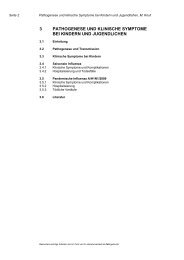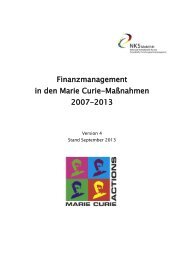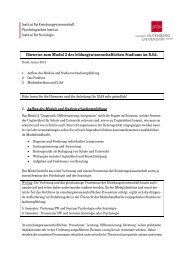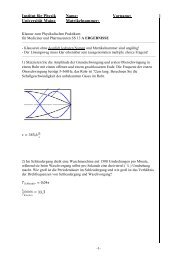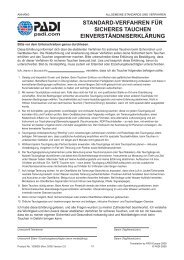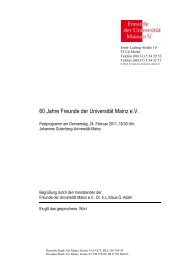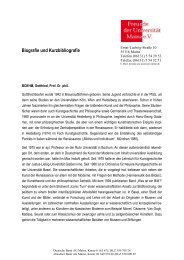Christof Rickert Seminar Softskills, 28.05.2010
Christof Rickert Seminar Softskills, 28.05.2010
Christof Rickert Seminar Softskills, 28.05.2010
You also want an ePaper? Increase the reach of your titles
YUMPU automatically turns print PDFs into web optimized ePapers that Google loves.
<strong>Christof</strong> <strong>Rickert</strong><br />
Gestaltung<br />
wissenschaftlicher Poster<br />
<strong>Seminar</strong> <strong>Softskills</strong>, <strong>28.05.2010</strong>
Ablauf<br />
•<br />
Was sind und sollen Poster?<br />
• Gestaltungsgrundlagen<br />
•<br />
Schrift und Text<br />
• Bilder<br />
•<br />
Kurze Einführung in Adobe Illustrator
ABSTRACT<br />
BACKGROUND<br />
PHOSPHOPROTEIN PHOSPHATASE 2A CATALYZES THE DEPHOSPHORYLATION<br />
OF pSer129 ALPHA-‐SYNUCLEIN<br />
Jeffry. B. Stock 1, 2 , Xuyan Feng 2 , Yang Chao 2 , Walter Chen 1 , Neelanjana Ray 2 , Tsuyoshi Ishii 1,2 , Jose R. Fernandez 2 , Yi Liu 2 ,<br />
Arvind Raghavan 2 , Maxwell Stock 2 , M. Maral Mouradian 3<br />
1 Dept. of Molecular Biology, Princeton University, Princeton, NJ, USA. 2 Signum Biosciences, Monmouth Junction, NJ, USA. 3 Dept. Neurology, UMDNJ-RWJMS, Piscataway, NJ, USA<br />
Modulation of phosphatase activity is a promising approach for<br />
the development of therapeutics targeting hyperphosphorylated<br />
proteins in neurodegenerative diseases. (See Poster # 238.6/G7;;<br />
�ENHANCING PROTEIN PHOSPHATASE 2A ACTIVITY IS<br />
NEUROPROTECTIVE IN MOUSE MODELS OF �����������<br />
DISEASE�� .<br />
Phosphoprotein phosphatase 2A (PP2A)<br />
� Multi-subunit protein, accounts for over 50% of brain Ser/Thr<br />
phosphatase activity<br />
� Dimeric core enzyme composed of 65-kDa scaffold A-subunit &<br />
36-kDa catalytic C-subunit.<br />
� Various B subunits serve to regulate PP2A specificity1 .<br />
� Reversible carboxyl-methylation at C-terminal Leu309 of the Csubunit,<br />
increases affinity of B subunit to AC dimers2 A pathological hallmark of Parkinson¹s Disease (PD) is the presence<br />
AB C form of PP2A<br />
of Lewy bodies (LBs) in surviving neurons whose major components � Accounts for over 70% of tau phosphatase activity in vivo<br />
include -synuclein ( -Syn). Phosphorylation of -Syn at serine 129<br />
(S129) facilitates its aggregation, and -Syn in LBs tends to be<br />
phosphorylated at S129. Several kinases that phosphorylate -Syn<br />
at S129 have been characterized, but the counteracting<br />
phosphatase(s) have not been identified. Here we show that protein<br />
phosphatase 2A (PP2A) is the major phosphatase that<br />
dephosphorylates S129 in an SH-SY5Y-derived neuroblastoma cell<br />
line that overproduces -Syn. This conclusion is supported by<br />
biochemical assays of P-S129 -Syn dephosphorylation using a<br />
variety of different purified and reconstituted phosphatase enzymes.<br />
In contrast to results obtained with PP2A, other major<br />
serine/threonine phosphatases including PP1, PP2B, and PP2C<br />
exhibit much lower activity toward P-S129 -Syn. PP2A activity is<br />
regulated by carboxyl methylation of the phosphatase catalytic<br />
subunit and our in vitro results indicate that PP2A methylation can<br />
act to enhance phosphatase activity toward P-S129 -Syn. These RESULTS<br />
findings raise the possibility that dysregulation of PP2A could<br />
contribute to -syn aggregation and to the pathogenesis of PD.<br />
--><br />
assembly of AB C heterotrimers (Figure 1).<br />
4<br />
� Tau mutations associated with FTDP-17 decrease affinity of PP2A<br />
for tau, in vivo5 � Loss of PP2A methylation and activity reported in brains of<br />
patients with �����������<br />
disease and ������ syndrome6,7 .<br />
A greater understanding of phosphatase specificities<br />
towards -synuclein is required to address the possible role<br />
of PP2A dysregulation in the etiology of ����������� disease<br />
and related synucleinopathies.<br />
4 Sontag E et. al., Neuron (1996), 17(6): 1201-1207.<br />
5 Goedert M et. al., J Neurochem. (2000), 75(5): 2155-2162.<br />
6 Gong CX & Iqbal K. Curr Med Chem. (2008), 15(23): 2321-2328.<br />
7 Sontag E et. al., J Neuropathol Exp Neurol. 2004), 63(10): 1080-1091.<br />
PP2A dephosphorylates pS129 -synuclein in SH-SY5Y cells.<br />
� Varying concentrations of broad-specificity phosphatase inhibitor<br />
okadaic acid (OA) and the PP1-specific inhibitor tautomycetin<br />
(Tc), were used to investigate relative activities of the two<br />
phosphatases in -synuclein over-expressing SH-SY5Y (SH-<br />
SY5Y/syn) cells.<br />
� 250 nM okadaic acid (OA) was used to specifically inhibit PP2A in<br />
SH-SY5Y/syn cells. Since PP1 activity is not completely abolished<br />
at this concentration of OA, extracts were further treated with 35<br />
nM tautomycetin (Tc) and tested for PP2A activity (Fig. 2A).<br />
� SH-SY5Y/syn cells were also treated with 250 nM OA for 2h, and<br />
extracts were further treated with 2 M OA to test for PP1<br />
activity (Fig. 2B).<br />
� PP2B is inhibited only at much higher concentrations of OA (IC50 ~4�M) and PP2C is virtually insensitive to OA.<br />
� OA-treated extracts failed to dephosphorylate pS129 -synuclein,<br />
while Tc-treated extracts showed little or no effect on pS129 -<br />
syn (Fig. 2C).<br />
A B<br />
ight protected. F1000 Poster Bank. Copyright protected. F1000 Poster Bank. Copyright protecte<br />
� Methylation catalyzed by a PP2A-specific, S-adenosyl methionine<br />
(SAM)-dependent methyltransferase (PPMT)<br />
� Demethylation is mediated by a PP2A-specific methylesterase<br />
(PME-1) 3 (Figure 1).<br />
Figure 1<br />
Scaffold (A) subunit<br />
Catalytic (C) subunit<br />
PME-1<br />
(-) CH3<br />
AC core dimer<br />
(+) CH3<br />
Regulatory (B) subunit<br />
1<br />
Lechward et. al., Acta Biochim. Pol. (2001), 48(4): 921-933.<br />
2<br />
Tolstykh L et. al., EMBO J. (2000), 19(21): 5682-5691.<br />
3<br />
Lee J & Stock JB. J Biol. Chem. (1993), 268(26): 19192-19195.<br />
PPMT<br />
PP2A holoenzyme<br />
Figure 2. PP2A dephosphorylates pS129 -‐syn in SH-‐SY5YA cells. (A) SH-‐SY5Y/syn cells<br />
were treated with EtOH (Ctl) or 250 nM okadaic acid (OA) for 1 h. Ctl and OA-‐treated<br />
cell extracts were then incubated with DMSO or 35 nM Tc (to completely inhibit PP1)<br />
respectively. Inhibitor-‐treated extracts were assayed for PP2A activity (defined as the<br />
fraction of activity resistant to 35 nM Tc but inhibited by 5 nM OA), using 32P-‐labelled phosphorylase a. Activity is expressed as a percentage of PP2A activity in Ctl cells. *P <<br />
0.01 by ��������� t-‐test. Data are mean ± SD. (B) SH-‐SY5Y/syn cells were treated with<br />
EtOH (Ctl) or OA (250 nM) for 2 h. Extracts were incubated with 5 nM OA or 2 ��OA<br />
prior to PP1 activity assay (defined as the fraction of activity resistant to 5 nM OA but<br />
inhibited by 2 ��OA), using 32P-‐labeled phosphorylase a. Activity is expressed as a<br />
percentage of PP1 activity in Ctl-‐treated cells. Data are mean±SD of duplicate assays,<br />
representative of three experiments. (C) SH-‐SY5Y/syn cells were treated with EtOH<br />
(Ctl) or 250 nM okadaic (OA) for 1h. Extracts were analyzed by Western blotting using<br />
antibodies against pS129 -‐synuclein and total -‐synuclein (Abcam).<br />
Copyright protected. F1000 Poster Bank. Copyright protected. F1000 Poster Bank. Copyright protected. F1000 Pos<br />
C<br />
PP1 is not the primary pS129 -synuclein phosphatase in<br />
neuroblastoma cells.<br />
� PP2A and PP1 constitute approximately 90% of the total Ser/Thr<br />
phosphatase activity in mammalian cells.<br />
� We treated SH-SY5Y/syn cells with 1 M tautomycetin (Tc), a PP1specific<br />
inhibitor. Cell extracts were then treated with varying<br />
concentrations of okadaic acid (OA) to investigate relative<br />
activities of the two enzymes in these cells (Fig. 3A).<br />
� Tc-treated lysates did not affect pS129 -syn (Fig. 3B), indicating<br />
that PP1 does not dephosphorylate -synuclein at this residue.<br />
Figure 3. Evaluation of PP1 & PP2A activities in neuroblastoma cells. SH-‐SY5Y/syn<br />
cells were treated with DMSO (Ctl) or 1 M tautomycetin (Tc) for 20 min. (A) Cell<br />
extracts were then either untreated, or incubated with 5 nM and 2 M okadaic acid,<br />
to define PP2A, PP1 and residual phosphatase activities respectively. Inhibitor-‐treated<br />
extracts were assayed for phosphatase activity using 32P-‐labelled phosphorylase a. *P<br />
����������������������<br />
-‐test. All data shown are mean ± S.D. of duplicate assays and are<br />
representative of three experiments. (B) SH-‐SY5Y/syn cells were treated with DMSO<br />
(Ctl) or tautomycetin (Tc) for 20 min. (right panels). Extracts were analyzed by Western<br />
blotting using antibodies against pS129 -‐synuclein and total -‐synuclein (Abcam).<br />
PP2A, but not PP1, dephosphorylates pS129 -syn in vitro.<br />
Figure 4. In vitro dephosphorylation of pS129 -‐synuclein. Purified human -‐<br />
synuclein was phosphorylated in vitro with CK2 (NEB). Purified, unmethylated and<br />
reconstituted PP2A (AC-‐dimer), and purified PP1 were incubated at the indicated<br />
concentrations with phospho-‐ -‐syn for 30 min. at 30 o C. Reactions were analyzed by<br />
Western blotting using pS129 -‐synuclein (pS129 -‐syn) antibodies (Abcam).<br />
PP2A activities towards phosphorylated -synuclein are<br />
dependent on methylation and subunit composition.<br />
Methylation of the AC dimer (Fig. 5A) enhances PP2A activity<br />
towards pS129 -synuclein.<br />
A<br />
PP1<br />
PP2A<br />
PP1 Activity (5nM OA-insensitive,<br />
2 M OA-inhibited)<br />
PP2A Activity (5nM OA-inhibited)<br />
Residual Activity (2 M OA-insensitive)<br />
0 2 20 200 (nM)<br />
Figure 5. Differential PP2A activities towards pS129 -‐synuclein. (A) Phosphorylated<br />
-‐synuclein was prepared as described in Figure 4. Unmethylated or in vitro methylated<br />
PP2A AC-‐dimers were incubated at the indicated concentrations for 30 min. at 30 o C with<br />
phospho-‐ -‐synuclein, reactions were analyzed by Western blotting using pS129 -‐<br />
synuclein (pS129 -‐syn) antibodies (Abcam).<br />
Copyright protected. F1000 Poster Bank. Copyright protected. F1000 Poster Bank. Copyright protected. F1000 Poster Bank. Cop<br />
opyright protected. F1000 Poster Bank. Copyright protected. F1000 Poster Bank. Copyright protected. F1000 Poster Bank. Copyright protect<br />
A<br />
B<br />
Figure 5.<br />
Methylation of the trimeric holoenzyme (Fig. 5B), enhances PP2A<br />
activity towards pS129 -synuclein.<br />
B PP2A 0 12 25 50 100 200 nM<br />
The trimeric holoenzyme containing the B -subunit (AB C)<br />
dephosphorylates pS129 -syn more efficiently than holoenzymes<br />
containing the ��(���C), ������ C), or ��� ������� holoenzymes.<br />
C<br />
Demeth-AC<br />
Demeth-AB�C<br />
Meth-AB�C<br />
PP2A 0 12 25 50 100 200 nM<br />
AB�C<br />
����C<br />
���1C<br />
�����<br />
Figure 5. Methylation-‐dependent phosphatase activities towards phospho-‐synuclein.<br />
Phosphorylated -‐synuclein was prepared as in Figure 4. Purified, methylated and<br />
reconstituted PP2A enzymes at the indicated concentrations were incubated with<br />
phospho-‐ -‐synuclein for 30 min. at 30 o C. Reactions were analyzed by Western blotting<br />
with pS129 -‐syn and Total -‐syn antibodies (Abcam). (B) Demeth-‐AC or Meth-‐AC<br />
dimers were reconstituted with B subunit to yield Demeth-‐AB C and Meth-‐AB C<br />
holoenzymes respectively. (C) Demeth-‐AC was reconstituted in vitro with B , �� , ��<br />
and ���subunits to yield the AB C, ��� C, ��� C, and �����holoenzymes respectively.<br />
,<br />
SIG1012, a small-molecule PME-1 inhibitor, reduces PP2A<br />
demethylation and pS129 -syn levels in SH-SY5Y/syn cells.<br />
% of untreated<br />
120<br />
100<br />
Figure 6. SIG1012 reduces PP2A demethylation and phospho-‐syn levels in cells. SH-‐<br />
SY5Y/syn cells were incubated with the indicated SIG1012 concentrations for 4 h.<br />
Lysates were analyzed by Western blotting using antibodies to PP2A demethylated C-‐<br />
subunit (Demeth-‐C; Millipore) and total C-‐subunit (Total-‐C), pS129 -‐syn (p-‐syn) and<br />
total -‐syn (Abcam). Signal intensities were normalized to respective loading controls,<br />
data are average normalized intensities from 3 independent experiments; * p < 0.05.<br />
CONCLUSION<br />
80<br />
60<br />
40<br />
20<br />
0<br />
0 uM SIG1012 5 uM SIG1012 25 uM SIG1012<br />
*<br />
*<br />
Demeth-C/Total-C p-syn/Total-syn<br />
� In SH-SY5Y/syn cells, -synuclein is dephosphorylated primarily by<br />
PP2A, not PP1.<br />
� Biochemically reconstituted AB C PP2A holoenzymes dephosphorylate<br />
-synuclein more efficiently than other trimeric forms.<br />
� Dephosphorylation of phospho- -synuclein by PP2A is methylationdependent.<br />
� In neurodegenerative diseases, inhibition of PP2A demethylation may<br />
offer a novel therapeutic approach towards reducing phosphorylation<br />
proteins such as -synuclein.<br />
This work was supported by funding from the American ����������� Disease Foundation.<br />
*<br />
*<br />
pS129 -syn<br />
pS129 -syn<br />
pS129 -syn<br />
Total -syn<br />
pS129 -syn<br />
pS129 -syn<br />
pS129 -syn<br />
pS129 -syn<br />
opyright protected. F1000 Poster Bank. Copyright protected. F1000 Poster Bank. Copyright protected. F1000 Poster Bank.<br />
oster Bank. Copyright protected. F1000 Poster Bank. Copyright protected. F1000 Poster Bank. Copyright protected. F1000 Poster Bank.<br />
cted. F1000 Poster Bank. Copyright protected. F1000 Poster Bank. Copyright protected. F1000 Poster Bank. Copyright protected. F1000 Po<br />
Total -syn<br />
Poster Bank. Copyright protected. F1000 Poster Bank. Copyright protected. F<br />
ected. F1000 Poster Bank. Copyright protected. F1000 Poster Bank. Copyright protected. F1000 Poster
!"#$%&' () !**+,-%.//(0*1<br />
2/34%56 2/34%'7%899'7%",*%20/1:7%#,-0;:,
Poster sollen Kommunizieren.<br />
•<br />
•<br />
•<br />
•<br />
Ergebnisse werden auf Tagungen präsentiert, während man meist<br />
selbst daneben steht.<br />
Poster sollen klar und verständlich sein aber auch<br />
Diskussionsgrundlage bieten.<br />
AIDA: Attraction, Interest, Desire, Action<br />
„Weniger ist mehr.“<br />
• Zielgruppe?
Logo<br />
Bilder<br />
Kontakt<br />
Titel<br />
Text Gorgeo<br />
Du
Der Aufbau: logisch und ansprechend<br />
• Stimmen die Proportionen der Elemente:<br />
– Je wichtiger umso grösser, umso stärker hervorgehoben...<br />
• Relevanz:<br />
– Ist der Aufbau nachvollziehbar?<br />
– Wird ersichtlich, weshalb was wo platziert ist?<br />
• Ist die Leserichtung klar?<br />
• Konsistenz:<br />
– Macht das Gesamtbild Sinn?<br />
– Gibt es noch Fremdkörper?<br />
– Sind alleTeile gut eingebunden?
Schriften<br />
h<br />
h<br />
mit Serifen<br />
ohne Serifen (= Groteske)<br />
ohne Serifen<br />
ohne Serifen<br />
ohne Serifen
•<br />
•<br />
Faustregeln zur<br />
Verwendung von Schriften<br />
auf keinen Fall mehr als 3 verschiedene Schriften auf einem Poster<br />
Serifenlose Schriften eigenen sich besser für Überschriften.<br />
• Fließtext und Abbildungstexte sind in Serifenschriften leichter lesbar.<br />
• Hervorhebungen sind am elegantesten in fett oder kursiv.<br />
• besser nie mehr als 250 Wörter am Stück.<br />
• Schrift groß genug.<br />
Überschriften und Kernsätze aus 3 m lesbar (mindestens 80 –100 pt)<br />
sonstiger Text aus 1 m von drei Leuten gleichzeitig lesbar (40 –50 pt).<br />
Nicht durch Verkleinern der Schrift mehr Text auf das Poster zwängen.
Faustregeln zum<br />
Setzen von Text<br />
Text im Blocksatz enthält<br />
ungleichmäßige Buchstaben- und/<br />
oder Wortzwischenräume,<br />
insbesondere bei langen Wort-<br />
Ungetümen in kurzen Zeilen – am<br />
‚besten‘ noch ohne<br />
Silbentrennung.<br />
Am besten leserlich und leicht<br />
umzusetzen ist linksbündiger Flattersatz.<br />
Rechtsbündiger oder zentrierter Satz<br />
erschwert das Auffinden der nächsten<br />
Zeile und somit das Lesen ungemein.<br />
Wichtig im Flattersatz ist ein genügender<br />
Spaltenabstand.<br />
die ideale Zeilenlänge ist maximal 70 Zeichen<br />
Der ideale Zeilenabstand ist Schriftgröße + 20%
Zeichen<br />
Striche<br />
- = Verbindungstrich, wie in Hin- und Rückweg. Dies ist kein Gedankenstrich.<br />
– (alt + -) = Gedankenstrich – für Aufzählungen und Einschübe<br />
Anführungszeichen<br />
dt.: Anfang 99 unten, Ende 66 oben: „Anführungszeichen“<br />
eng.: Anfang 66 oben, Ende 99 oben: “quotation marks”<br />
bitte nicht mit dem Zoll- bzw. Sekundenzeichen ʺ″ verwechseln.
Farben Farben Farben Farben<br />
für Schrift<br />
Schwarz auf weiß ist bei weitem am besten<br />
leserlich und optisch am wenigsten<br />
irritierend.<br />
Faustregel: Lange Lesetexte schwarz auf<br />
weiß, Überschriften auch farbig.<br />
für Flächen<br />
Im Poster sollten nicht mehr als drei Farben<br />
(neben schwarz) auftauchen, sonst wirkt es<br />
bunt und schrill.<br />
Rot, Orange und bestimmte Grüntöne sind<br />
sehr laut, ebenso das Nebeneinander von<br />
Komplementärfarben. Diese Farben und<br />
Kombinationen sollten nur ganz bewusst<br />
eingesetzt werden.<br />
Der Hintergrund darf die Schrift nicht stören.<br />
Also nur dezente Farbtöne und keine<br />
detailreichen Bilder.
Grafiken und Bilder<br />
Viel Bild – wenig Text!<br />
Daten sollten immer grafisch aufbereitet sein.<br />
Niemand will auf Tagungen lange Tabellen studieren.<br />
Bilder bzw. Fotos sollten auf dem Poster am besten mindestens<br />
100 Pixel/cm (entspricht 250 Pixel/Inch) besitzen.<br />
Bilder müssen selbsterklärend sein. Bildunterschriften sind unerlässlich.
an der Uni Mainz<br />
•<br />
Poster können bis DIN-A0 im ZDV (DTP-Studio)<br />
ausgedruckt werden (18€)
Quellen:<br />
• http://www.ag-jlc.de/images/stories/JLC/Dokumente/<br />
posterworkshopsept2007handout.pdf<br />
• http://www.asanger.de/asig/Postererstellung.pdf<br />
• http://www.diz.ethz.ch/docs/powerful_posters<br />
• http://www.staff.uni-mainz.de/pommeren/Vortraege/Gutes_Poster.pdf



